|
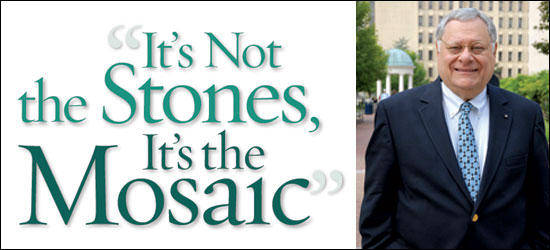
Julie Woodford
How President Stephen Joel Trachtenberg
transformed the University one brick—and
one person—at a time.
By Leslie Milk

|
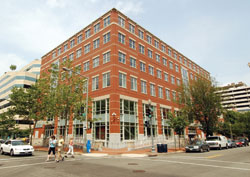
Under Trachtenberg’s
leadership, GW opened or renovated nearly
a dozen buildings. Among them: The Media
and Public Affairs Building opened on the
corner of 21st and H Streets in 2001.
Julie Woodford
|
According to the District of Columbia,
Dec. 4, 2006, was Stephen Joel Trachtenberg Day
in Washington. The mayor’s proclamation
praised Trachtenberg as “one who exemplified
the spirit, vitality, and deeds that enhanced
the quality of life in the District of Columbia.”
But for The George Washington University students,
faculty, neighbors, and many in the city of Washington,
every day for the past 19 plus years has been
Stephen Joel Trachtenberg Day. Trachtenberg has
excited, exhorted, encouraged—and occasionally
infuriated—some or all of them. He wouldn’t
have it any other way.
When he came to Washington in 1987 to meet with
the search committee seeking a University president
to follow Lloyd Elliott, “They asked me
if I wanted to challenge myself at a university
whose faculty wanted to go to the next level,
“ Trachtenberg recalls. “They wanted
a president to work with them to make that happen.”
What he found was “an established university
that had room to grow and was uniquely positioned
to add to its academic reputation,” Trachtenberg
says. He also found a campus that didn’t
look like a campus and a faculty and a student
body who felt that they couldn’t compare
to the other “George” in town. In
addition, GW wasn’t taking full advantage
of one of its greatest assets—its location
at the heart of the nation’s capital. For
a Brooklyn-born city boy like Trachtenberg, that
was an opportunity to be relished. Capitalizing
on the capital would be a win-win for both the
city and the university, he believed.
Nearly 20 years later, Trachtenberg has surpassed
many of his original aspirations and, in the words
of The Washington Post, “helped
transform the school from a sleepy institution
to one of national stature.” In the process,
he became the longest-serving university president
in Washington in an era where university presidents
who last more than a decade are as rare as spotted
owls.
Many of his accomplishments are visible and quantifiable.
For example, Trachtenberg raised the University’s
endowment from $200 million to $1 billion.
But the full impact Trachtenberg has had requires
a long-range view. “It’s not the stones,
it’s the mosaic,” he says. “There
are lots of bits and pieces. Take for example
our school of public health: These things, once
you develop them, take on a life of their own
that carries them forward. That school is going
to make a contribution to the city, to the country,
and to the world.”
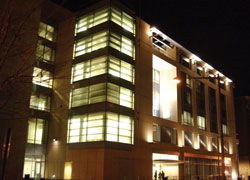
The state-of-the-art
Duquès Hall, home to the School of
Business, opened in 2006.
Julie Woodford
|

|
If You Build It ....
Bricks and mortar do not make a university, but
they do make a university more attractive to both
the faculty and students, Trachtenberg believes.
“It’s not an edifice complex. You
are building buildings because they are tools
for academic work and for scholarship,”
he says.
Under Trachtenberg’s leadership, GW opened
or renovated nearly a dozen buildings, including
the Media and Public Affairs Building and the
establishment within of the Luther W. Brady Art
Gallery, the Annette and Theodore Lerner Family
Health and Wellness Center, and 1957 E Street,
home to GW’s Elliott School of International
Affairs and the Department of Geography. The Marc
C. Abrams Great Hall was dedicated in 2002, J
Street Dining in the Marvin Center was completed
in 2004, and Duquès Hall, home to the School
of Business, opened in 2006. There also are five
new residence halls on the Foggy Bottom Campus.
The University substantially upgraded its library
system—there are more than two million books
in its libraries now and GW was accepted for membership
in the prestigious Association of Research Libraries.
At the same time, GW added two new campuses.
The 95-acre Virginia Campus in Ashburn, Va., opened
in 1991 with graduate programs in transportation
safety and security, public health and homeland
security, professional and executive education,
and information technology and telecommunications.
The Virginia Campus has more than a dozen laboratories
and research centers—fueled by partnerships
with Northern Virginia’s high-tech companies.
In 1997, the University acquired Mount Vernon
College on Foxhall Road in Northwest D.C. Just
three miles west of the Foggy Bottom Campus, the
Mount Vernon Campus is home to classrooms, laboratories,
interior design studios, various athletic and
recreation facilities, and residence halls.
During the Trachtenberg era, GW created the School
of Public Health and Health Services, the School
of Public Policy and Public Administration, the
College of Professional Studies, the Graduate
School of Political Management, and the School
of Media and Public Affairs.
“Buildings alone don’t teach,”
Trachtenberg said at the ribbon-cutting ceremony
for Duquès Hall, a new facility for GW’s
School of Business. “But... buildings like
Duquès and Funger Halls provide us with
the space, technology, and the modalities that
are absolutely necessary for the contemporary
study of business.”
Trachtenberg also oversaw the opening of the
new GW Hospital, the first hospital to open in
the District of Columbia in more than 25 years.
“We have world-class doctors who deserve
a world-class facility,” he says.

|
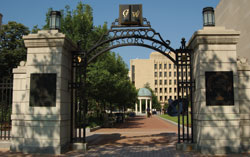
A major enhancement
to GW’s aesthetics during Trachtenberg’s
presidency is the addition of the Mid-Campus
Quad and Kogan Plaza, which have become
gathering places for students. Trachtenberg
led many improvements to the campus, including
the addition of banners, statues, and archways.
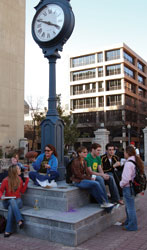
Julie Woodford
|
The location and reputation of GW’s medical
school and medical center have attracted some
very prominent patients and they, in turn, have
enabled the University to increase its treatment
and research capabilities. The Ronald Reagan Institute
of Emergency Medicine was established in 1991
to honor GW doctors for saving President Reagan’s
life. Just last year, Vice President Dick Cheney,
who has been treated by GW cardiac surgeons, and
his wife, Lynne, donated $2.7 million to create
the Richard B. and Lynne V. Cheney Cardiovascular
Institute at GW.
When he arrived at GW, Trachtenberg inherited
a campus that had expanded without rhyme or reason.
As the University grew, it had often acquired
buildings that had been designed for other purposes.
The Foggy Bottom Campus was undistinguished and
undefined. “There is no there there,”
observers quipped.
“He had a sense from the first day that
the campus had the potential for physical and
aesthetic cohesion,” says Trachtenberg’s
wife Francine Zorn Trachtenberg. “He began
to envision ways to give it form and shape.”
“We put a little lipstick on, we put a
little kohl under the eyes,” Trachtenberg
says of his campus beautification initiative.
Four large busts of George Washington now grace
the Foggy Bottom Campus. There are iron and stone
gates to delineate the campus, banners in GW colors
on light posts, new brick walkways, outdoor sculptures,
vest-pocket parks, and teak benches. The Mid-Campus
Quad with its Kogan Plaza, fountain, and tempietto
has become a gathering place for students—the
University’s outdoor living room.
Time to Teach, Time to
Research
GW has had a 25 percent increase in full-time
faculty members since 1988, including a 90 percent
increase in the number of women faculty members
and a 175 percent increase in the number of minority
faculty members. “Over time, we’ve
recruited new, young, scholarly faculty who are
committed to teaching,” Trachtenberg says.
“We’ve provided them with the facilities
they need to do their research—laboratories,
computers, and time. Time can never be underestimated
as a resource for professors.”
Improving faculty salaries was another Trachtenberg
goal achieved. Competitive salaries are a powerful
recruiting tool—GW salaries for full professors,
associate professors, and assistant professors
now rank in the 80th percentile or higher, according
to the American Association of University professors.
The number of endowed chairs has more than doubled.
GW also has seven University Professors on campus—a
designation created to attract renowned scholars.
As of Aug. 1, Trachtenberg will join their ranks
as he becomes the University Professor of Public
Service. Upon his departure from GW, this professorship
will forever become the Stephen Joel Trachtenberg
University Professor of Public Service.
During his presidency, Trachtenberg has taken
advantage of GW’s closeness to the seats
of power to lure professionals from the federal
government, medical and research centers, businesses,
and international organizations to teach at the
University on a part-time basis. Then there are
the teachers who never see the inside of a classroom—the
world and national leaders who come to speak on
campus. Because of the quality of its students
and faculty, as well as its location, GW has become
such a popular venue that a U.S. senator recently
called Trachtenberg to ask if he could speak on
campus. He had a new book coming out, the senator
said, and he wanted to talk about it at GW.
In addition, students have had opportunities
to learn from topflight broadcast journalists.
Since April 2002, CNN has aired 775 programs including
Crossfire, On The Story, and Reliable
Sources from GW’s Media and Public
Affairs Building, with 260 students serving as
production interns and 123,000 students, faculty
members, staff members, area residents, and visitors
to the nation’s capital participating as
audience members.
Scholarly research also has flourished during
the Trachtenberg years. Total research funding
has nearly quadrupled from $33 million in 1988
to nearly $132 million in 2006. GW now houses
80 chartered research centers and institutes—up
from 58 in the late 1990s.
The work of these research centers has advanced
scholarship and yielded important real-world benefits.
For example, the Ronald Reagan Institute of Emergency
Medicine had been working for a decade on international
emergency medicine, and disaster response and
prevention when disaster struck on 9/11. The institute
was able to assist FEMA and the World Trade Center,
and was involved in search-and-rescue at the Pentagon.
A $1.5-million grant from the W.M. Keck Foundation
helped to create the Institute for Proteomics
Technology and Applications. The institute benefits
from the combined efforts of three GW schools
and is already developing a protein microscope
to allow researchers to see proteins interacting
in living tissue. The hope is that scientists
will be able to use this information to develop
new treatments for diseases that cause nerve degeneration,
such as ALS, also known as Lou Gehrig’s
disease.
Research at GW runs the gamut from discovering
dinosaurs in China to digging for evidence of
King Solomon in the Israeli desert, to developing
on its Virginia Campus a Drowsy Driver Detection
System, which warns sleepy drivers to pull off
the road.
In addition to the investigative work of GW’s
faculty researchers and graduate students, the
George Gamow Undergraduate Research Fellowship
was inaugurated in 2002 to encourage talented
undergraduates by getting them involved in faculty
research projects. The Columbian College of Arts
and Sciences Luther Rice Undergraduate Research
Fellowships, started in 2003, support projects
generated by more advanced students. These kinds
of academic opportunities have helped GW to attract
the best and brightest students in its history.
“Quality Students
Bring Joy to a Professor’s Heart”
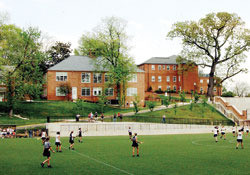
GW added two
new campuses during Trachtenberg’s
presidency. The 95-acre Virginia Campus
in Ashburn, Va., opened in 1991. In 1997,
the University acquired Mount Vernon College
on Foxhall Road in Northwest D.C. GW’s
athletics fields are now located at the
Mount Vernon Campus, pictured here.
Claire Duggan
|

|
The George Washington University is now a first
choice school for many high school students. When
Trachtenberg arrived, there were 6,389 applicants
for the freshman class, and 78 percent were admitted.
In 2006, the applicant pool jumped to 19,500,
and the acceptance rate for incoming freshmen
fell to 37 percent.
“We’ve got a buzz going on now,”
Trachtenberg says.
The ability of GW to attract a bigger and better
applicant pool is no accident. Trachtenberg has
made a conscious and concerted effort to make
GW more visible and more prestigious to a wider
group of students. “I’m going to use
words that most university presidents are embarrassed
by,” he says. “At some level, you
have to think of potential students as customers.”
To attract these customers, the University stepped
up its efforts in strengthening and expanding
academic programs, facilities, student services,
and athletic programs, among others.
Creating new academic programs geared to high
achievers was one way to demonstrate GW’s
capacity to challenge top-ranked students and
show that a big school could think small. The
University Honors Program began in the mid 1990s
with classes of no more than 20, special seminars,
and provocative topics like “The Politics,
Philosophy, and Economics of Poverty.” In
2003, the University Writing Program was created,
offering another opportunity for students to study
in small groups. The expectation of the program
is that students will become better writers and
more engaged in their education.
GW also launched select undergraduate programs
that encourage dialogue between students and professors—the
Dean’s Seminar Series in Columbian College,
the Dean’s Scholars in Globalization Program,
and the Women’s Leadership Program on the
Mount Vernon Campus.
Trachtenberg also recognized the importance of
athletics in building a university’s visibility
and school spirit. “The very best students
like to come to a school where there is good athletic
opportunity for them and good athletic performance
by the school’s teams,” he says. He
points to Duke and Stanford as universities that
boast both academic excellence and outstanding
athletic programs.

|
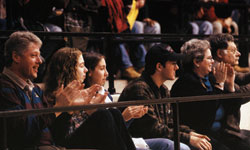
GW’s basketball
program flourished during Trachtenberg’s
tenure. Here, President Bill Clinton, daughter
Chelsea, and Chelsea’s friend join
President Trachtenberg, his wife, Francine,
and their son, Ben, in the Charles E. Smith
Athletic Center for the GW v. U. Mass game
on Feb. 4, 1995. GW defeated U. Mass., 78–75.
|
Enter men’s basketball coach Mike Jarvis.
Hired to coach the Colonials in 1990, he led GW
to three NCAA tournament appearances, including
the “Sweet Sixteen” in 1993. In the
2005-06 season, the men’s team went undefeated
in regular season A-10 play under leadership of
current coach Karl Hobbs. This season, longtime
women’s coach Joe McKeown, who has coached
his GW team to 13 NCAA appearances, was named
A-10 coach of the year for the fifth time after
leading his team to an undefeated A-10 regular
season. Once somewhat empty during home games,
GW’s Charles E. Smith Athletic Center now
vibrates during home games, with cheering fans
raising the roof.
At the same time, Trachtenberg helped to break
down financial barriers that might keep excellent
students out of GW. Since 1987, student financial
aid expenditures have risen from $14 million to
$118 million. To take the mystery out of tuition
planning, he created the Fixed-Tuition and Guaranteed
Institutional Financial Assistance Program in
2004. Incoming freshmen are guaranteed that their
tuition costs will remain the same for their full-time
undergraduate studies for up to five years. Likewise,
their minimum financial assistance is guaranteed
for up to 10 semesters. Their aid amount can increase
but not drop below the minimum they are granted
when they come to GW.
Everything that Makes
Washington Better Makes GW Better
The first year he was president of GW, Steve
Trachtenberg, who is Jewish, spent every other
Sunday at one of the city’s many churches.
It was a way to say that the University wasn’t
just in Washington, it was inexorably linked to
the city. GW is the largest private employer in
the District and many of its employees and alums
live in D.C. Trachtenberg has chaired the D.C.
Chamber of Commerce and served on the boards of
the Greater Washington Board of Trade, the Federal
City Council, and the Greater Washington Urban
League.
But Trachtenberg wanted to do more.
“I want people to know us as the University
that contributes more to Washington than any other
institution,” he has said.
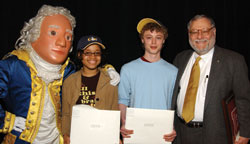
For 18 years,
the University has offered the “Stephen
Joel Trachtenberg Scholars” program,
which has provided more than 84 academically
talented D.C. Public High School seniors
with full, four-year scholarships covering
tuition, room and board, books, and fees.
GW’s total commitment since the inception
of the program is more than $12 million.
The scholarships, along with other grants
and work-study programs, make GW the largest
single post-secondary contributor of aid
to D.C. Public Schools for the last 13 years.
Julie Woodford
|

|
The Stephen Joel Trachtenberg Scholars program,
started in 1989, has awarded more than $13.5 million
to 93 of D.C. Public Schools’ best and brightest
graduates. They receive free tuition, books, fees,
and room and board. Originally called the 21st
Century Scholars Program, GW’s Board of
Trustees renamed the program in 1998 to honor
Trachtenberg and to celebrate his first decade
in office. The scholarships, along with other
grants and work-study programs, make GW the largest
single provider of post-high school aid to students
from the D.C. public schools. It’s a way
to keep potential community leaders close to home,
Trachtenberg believes.
Many of GW’s schools and colleges are involved
directly in supporting D.C. schools. The medical
center is involved in several health outreach
programs to District residents. Teams of undergraduates
and MBA candidates have assisted businesses in
D.C.’s economic development zones. In 2005-06,
more than 2,000 GW students and faculty and staff
members volunteered for more than 54,000 hours
with 66 community partners. GW also works with
more than 300 FRIENDS, a group of Foggy Bottom/West
End residents, to collaborate on neighborhood
issues.
Working to make Washington better is enlightened
self-interest, Trachtenberg believes. “It’s
the only way to enhance the institution and have
a chance at greatness. And it’s fun.”
He applauds the arrival of every new restaurant
or new museum. “It’s the multiplier
effect,” he says. Everything that makes
Washington better makes GW better.
He’s particularly pleased about Washington’s
new baseball team and city stadium. Trachtenberg
never forgave Walter O’Malley for moving
the Dodgers from his native Brooklyn to Los Angeles.
The Trachtenberg Touch
Trachtenberg credits his wife for making his
career possible. “I’m Francine’s
husband. I don’t mind being introduced that
way,” he says. In fact, the decision to
come to GW was a joint one. When it looked like
Trachtenberg was a serious candidate for the GW
presidency, Francine came with him to Washington
to see the school and the city. Her only other
visit to Washington had been a childhood tour
of the monuments.
Francine remembers her tour of the campus with
Ron Howard, a longtime GW administrator, who was
designated as her guide. Howard had been instructed
that Trachtenberg’s visit was confidential.
As they walked around GW, Howard was greeted by
many faculty members and students. He’d
stop to chat but never introduced his companion.
After several of these encounters, Francine told
Howard that she was uncomfortable being treated
like the woman who wasn’t there. They compromised—he
introduced her but told no one why she was there.

|
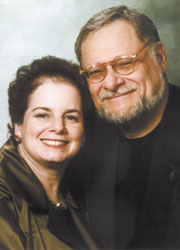
Francine Zorn Trachtenberg
has served the University in many areas.
President Trachtenberg credits her for making
his career possible. A scholar in her own
right, she has taught courses in the Department
of Fine Arts and Art History. In addition
to opening her home for countless events
for students, the faculty and staff, alumni,
and others, she has vigorously supported
the University’s art galleries and
artistic efforts, volunteered her time for
many GW and D.C. causes, and shared her
experiences by participating in the University’s
annual Women’s Leadership Conference.
|
Although her field of study was art history,
Francine takes no credit or blame for the bronze
hippopotamus that now graces the center of the
GW campus at H and 21st Streets. The family had
been on vacation and Francine left early to go
back to work. Trachtenberg announced that he had
sent her a gift. Then a delivery truck arrived
with two stone planters and the hippo. She instructed
the driver to unload the planters at the house
and told her husband to find another home for
the hippo.
Trachtenberg presented the bronze beast to the
University’s graduating class of 2000. Why
a hippopotamus? GW legend has it that hippos once
frolicked in the Potomac River to the delight
of George and Martha Washington, who watched them
from the porch at Mount Vernon. Hippos were credited
with bringing fertility to the plantation and
luck to anyone who could get close enough to touch
one of the beast’s noses.
While there are, in fact, no confirmed reports
of hippo sightings in the annals of American history,
the GW hippo often is pictured in the commemorative
photos families take of students on campus. It
has become an unofficial mascot with its own Web
site. Trachtenberg has received hippos as gifts
ever since.
It comes as no surprise to anyone who knows him
that Trachtenberg has decided to reinvent himself
as a University Professor of Public Service after
he leaves the GW presidency. He had already had
four professional lives—as an energy lawyer,
a Congressional aide cum education-policy wonk,
a doctoral candidate, and an assistant to the
U.S. Commissioner of Education—before he
arrived at Boston University as associate dean
in 1969.
He’ll teach an introductory course on public
policy. He also plans to write a book or two.
His first will be an “irreverent memoir”
of a university president, being published by
Simon & Schuster in the fall. Trachtenberg
has often said that university presidents give
up their first amendment rights. He is ready to
reclaim his. “Maybe I’m just beginning,”
he says.
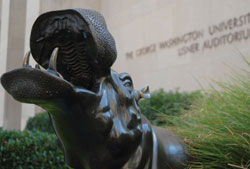
What has now
become a popular, though unofficial, mascot
of GW, the bronze hippo statue arrived on
campus as a gift to the graduating class
of 2000 from President Trachtenberg. Legend
has it that hippos once frolicked in the
Potomac River to the delight of George and
Martha Washington, who watched them from
the porch at Mount Vernon. Hippos were credited
with bringing fertility to the plantation
and luck to anyone who could get close enough
to touch one of the animal’s noses.
Jessica McConnell
|

|
An ardent writer of letters, as evidenced in
Write Me a Letter! The Wit and Wisdom of Stephen
Joel Trachtenberg, published last year by
The New Yorker Co. and its Cartoon Bank, Trachtenberg
often can be found composing correspondence to
associates and friends. Five years ago, Trachtenberg
wrote to Julius Edelstein, senior chancellor emeritus
of the City University of New York on the occasion
of Edelstein’s 90th birthday:
“I have taken you as my role model and
recently told the chairman of my board that if
GW will have me... at 70, I plan to do what you
have done, namely, become a professor... do some
teaching and writing, and pretend that I am thinking.
“Francine claims it would be good for us
to take up dancing. Having made it all these years
without dancing, I’m not certain I agree.
...Also, I’d like to have a dog. I always
wanted a dog, but my mother would not permit a
dog when I was a boy since we lived in an apartment
in Brooklyn, and she alleged it would not be fair
to keep a dog cooped up. I remonstrated that the
apartment was good enough for me—to no avail.
I can report with authority that hamsters are
not a satisfactory alternative. Hamsters I had.
On reflection I could have done without them.”
Leslie Milk is the lifestyle editor of The
Washingtonian magazine.
|